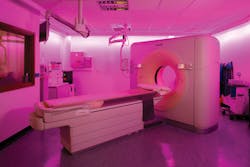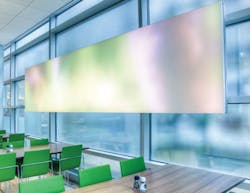Color peppers our language — feeling blue, in the pink — and now the psychology of color and the effects of light on our moods are being taken seriously in medical environments. CAROLINE HAYES finds out how LEDs can be used to relax, comfort, and enhance recuperation periods.
Color has been found to affect brain activity and hormone production, and to influence a person’s mood and emotions. This can be evidenced by physiological responses such as changes in blood pressure or the heartbeat. For instance, the color red can result in raised blood pressure and a quickened pulse, whereas blue typically has a calming effect.
As early as 1976, Rikard Kuller demonstrated that color and visual patterning affect both the brain's cortex and the body’s nervous system.1 Kuller determined that alpha brain wave activity is altered in reaction to the energy produced by the light carrying color. Then in 1996, Frank H. Mahnke published Color Environment & Human Response2, exploring the effects of color, both emotional and biological responses. Later experiments conducted by Lois Swirnhoff using highly saturated colors in room lighting found that blue calmed the senses of the subjects, but the effects of red light were inconclusive.3
The creation of lighting effects, largely enabled by LED lighting, is now used by the medical profession to inspire human alertness or create a more calming environment for patients. The brain’s hypothalamus reacts to color, producing different effects as the wavelength and energy of each color varies.
Core change
As LEDs have made colored lighting more accessible and controllable, many healthcare and medical centers are modifying light distribution, color, or the correlated color temperature (CCT) of white light (from cool to warm) to help patients while improving lighting and energy efficiency.
Gregg Ryberg, director of sales, healthcare, Cree, believes that the move away from a clinical to a welcoming environment is positive. “The healthcare industry is amidst one of the greatest core changes in the last 25 years,” he said, “shifting away from a clinical view to more of a hospitality view. As a result, improving patient satisfaction and wellbeing, while controlling costs, is critical for today’s healthcare providers, with lighting playing a tremendous role.”
He cited how quality of light is essential to create spaces that address clinical and emotional needs. For example, proper lighting distribution can be comforting for patients, while clean, crisp light is needed to help staff perform duties, assess wounds, and diagnose efficiently. “Soft, low-glare lighting can help foster a restful treatment and recovery environment, with a calm, soothing atmosphere for patients and families,” he said. “Less stressed, more comfortable patients tend to have better outcomes and spend less time in the healthcare facility.”
Technology drive
Another trend Ryberg identified is that the acquisition of the latest technology leads to adopting lighting that enhances the ambience of its setting.
One example is the CT (computerized tomography) scanner room at the Princess Alexandra Hospital, Harlow, UK. Superintendent radiographer Suzanne Browne explained the reason for introducing the Philips AmbiScene lighting system at the same time as commissioning a new CT scanner. “Experience shows that medical procedures such as CT scans can make some patients, and particularly children, feel quite anxious. The colored lighting effects in the room help create a more comforting atmosphere… We have found that it helps reduce anxiety levels.” If the patient is calm and still during the scan, then the procedure is more likely to succeed. “Since using the new scanner with the new dynamic lighting effects, we have been able to increase the number of successful scans from 25 to about 38 per day,” said Browne.
AmbiScene can be used in retail environments, mixing lamps, luminaires, and LEDs to direct shoppers to parts of a store, but in healthcare it is used to create a comforting environment. The lighting can be changed in color, intensity, or tone by staff using a simple touchpad control system in the observation room (Fig. 1). Variable, colored lighting can meet the needs of a particular situation or be altered at a patient’s request. (Color choice is not universal; some personal associations may mean that a patient is more soothed by purple, for example, than blue.)
In the project at the Princess Alexandra Hospital, yellow is the most popular color choice among patients and staff. The association with warm, sunny days may be an obvious one, but staff also report that they are able to see veins more clearly during examinations in this light.
AmbiScene lighting was also used in the MR (magnetic resonance) scanner room at the Marien Hospital in Hamburg, Germany as part of its renovation, with variable lighting to relax patients before treatment and with color as a communication system. For example, patients who may be hard of hearing, or for whom German is not their first language, can be asked to hold their breath when a particular light signal is given.
Adaptation
In many cases, it is not a large investment in equipment but upgrades that can lead to lighting projects. Ryberg identifies the difficulty with early linear LED retrofits in that they were not viable options for mass conversion, particularly for replacing the fluorescent tube lighting in healthcare. Much of the market delivered features that were compromised, he said, as well as products with safety concerns or slow payback. Ryberg explained, however, “upgrading is no longer a challenge,” referring to Cree’s UR Series LED upgrade kit. It is faster to install than previously complex upgrade kits, he said, and allows existing lighting fixtures to remain. The modern kit also eliminates ceiling plenum exposure during the upgrade, so the room can function and maintain its sanitary levels.
In other areas of a hospital, the harsh fluorescent lighting has been replaced by LED lighting, in particular in neonatal units and in wards where patients suffer dementia. For the infant units, LED lighting can be dimmed in a range of colors or CCTs for a soothing, less stressful environment. Lighting over a cot can be made brighter when needed to allow staff to examine the baby or analyze data on monitor screens.
In the UK’s Bradford Royal Infirmary, The Kings Fund installed a mix of fluorescent- and LED-based Philips Dynamic Lighting into two wards that have been adapted to support patients with cognitive problems and dementia. Using the fluorescent light, staff is able to adapt the lighting to mimic the natural rhythm of daylight (CCT around 5700K) in the wards. It has been found that more time spent in daylight — or daylight-like artificial light — improves a patient’s visual performance, their level of comfort, mood, sleeping and waking patterns, concentration levels, and alertness. Philips LuxSpace LED compact downlights are used in some patient areas with the same purpose — to modify white light from daylight to warm, evening levels (around 2700K). Bradford staff reported that the Dynamic Lighting led to a cheerful ambience that kept the patients active during the day and created more restful sleep patterns at night.
In other schemes, patients whose beds were next to a window were discharged more quickly, and Dynamic Lighting was used to mimic daylight in darker parts of the ward to aid restful, regular sleep patterns that contribute to recuperation.
Textile panels
In other areas of color and light research, it has been found that when light intensity is static, increased blinking reduces the ability to focus, causing eyestrain.
Luminous textile panels can be used to create color schemes but also to create a sense of movement or calm in intensive care units, for example, or to fit into a theme, such as summer in communal areas (Fig. 2). Philips uses Kvadrat textiles in its panels. Multicolor LEDs with a 60-mm pitch are integrated into an acoustic foam, which can be conditioned from 200 to 400 Hz to meet the area’s acoustic requirements. The panels are based on a patented aluminum frame, which has a concealed tensioning mechanism to keep the fabric stretched. The driver box and power supply are integrated into the frame to streamline the panel design. Standard power and Ethernet cables are used to upload and manage the content and can also be used to connect the panels to the building’s management system.
Cost savings
LED lighting can also help in the reduction of energy bills. According to Ryberg, 24/7 occupancy means that hospitals use around 2.5 times the energy of a similarly sized commercial building. “Healthcare organizations spend $6.5 billion on energy each year to meet patients’ needs,” he said. He elaborated, “LED lighting not only uses less energy because it is approximately 50% more energy efficient than fluorescents, but it also saves in maintenance and cooling costs. Cree LED luminaires are designed to last 30,000 to 50,000 hours, depending on application,” he said, “meaning hospitals can further cut costs by eliminating the need for constant relamping.”
He advised facility managers to evaluate an application in terms of layout, which can result in savings. It is possible that fewer fixtures are required to achieve the same lumen output and distribution for further cost savings, he observed.
One example of energy cost savings is the Raleigh Orthopaedic Clinic in North Carolina. The 98,000-ft2 headquarters and surgery center installed more than 1000 Cree CR Series LED architectural troffers.
The center uses the dimming capability in the diagnostic exam rooms, where Raleigh Orthopaedic president Dr. G. Hadley Callaway says staff and patients are better able to view X-rays while discussing treatment.
Cree CR22 and CR24 LED troffers produce 90 CRI for clean, clear light, deemed superior to that of fluorescents. The CR22 troffer provides a minimum of 90 lm/W standard efficacy and the CR24 delivers up to 5000 lm of 90-plus CRI at 90 to 110 lm/W. Both fixtures are designed to last 50,000 to 75,000 hours. The clinic’s installation is expected to decrease lighting energy use by 54% compared to fluorescent technologies and pay for itself in less than three years, said the company.
In addition to energy savings, the troffers also create quiet ceilings, says the company. The design distributes light for a flush, low-glare ceiling lighting scheme. The troffers are also recessed, reducing maintenance caused by dust collection. They are powered by Cree TrueWhite Technology and, in addition to producing 90 CRI and consistent color temperatures, they also offer a dimming function to brighten areas for evaluations or to create calming, welcoming areas, as necessary (Fig. 3).
The move to lighting controls is happening at a slower rate than LED lighting adoption. Ryberg believes that simplicity is the key to adoption. He cited Cree’s SmartCast technology, describing it as the first self-programming wireless lighting control system that reduces energy consumption by up to 70% (compared to traditional fluorescent luminaires without SmartCast technology) when used with Cree LED luminaires.
The blend of lights, dimmers, and pushbutton activation controls lighting in sensitive areas, like labs and, with occupancy and motion sensors, can also be used in areas where patients may need help navigating, or to illuminate outside areas such as car parks or walkways for safety.
REFERENCES
1. Kuller, Rikard, “Non-visual Effects of Light and Colour: Annotated bibliography,” Document/Swedish Council for Building Research, 1976, out of print.
2. Mahnke, Frank, Color Environment & Human Response, Wiley, 1996.
3. Swirnhoff, Lois, Dimensional Color, Norton, W.W. & Company, Inc., 2003.
CAROLINE HAYES is a contributing editor with LEDs Magazine.








